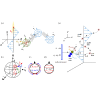Efficient navigation of cargo-towing microswimmer in non-uniform flow fields
引用次数: 0
Abstract
The vision of deploying miniature vehicles within the human body for intricate tasks holds tremendous promise across engineering and medical domains. Herein, optimal navigation of a cargo-towing swimmer under an applied zig-zag flow is studied by employing direct numerical simulations coupled with a deep reinforcement learning algorithm. Tasks include navigation in flow and shear-gradient directions. We initially explore combinations of state inputs, finding that optimal navigation necessitates swimmers to perceive hydrodynamics and alignment, surpassing reliance solely on hydrodynamic signals while considering their memories. Next, we study combinations of action spaces, allowing dynamic changes in swimming and/or rotational velocities by tuning and parameters of the squirmer model, respectively. By keeping both parameters fixed, cargo-towing swimmers demonstrate superior performance in the flow direction compared to swimmers without load due to tumbling movements influenced by shear flow. In the shear-gradient direction, swimmers without load outperform cargo-towing swimmers, with performance decreasing as load length increases. Across the combination of allowing and to change, the policies from solely dynamic actions demonstrate superior navigation. The policies are then used as a showcase against naive cargo-towing and inert colloidal chains. A t-distributed stochastic neighbor embedding analysis reveals the complex interplay between perceived hydrodynamic signals and swimmer position. In the flow direction, swimmers align effectively with regions of maximum velocity, while in the shear-gradient direction, periodic transitions from minimum to maximum state values occur. Comparing pullers, pushers, and neutral swimmers, cargo-towing swimmers show a reversal in swimming velocity trends, with pullers outpacing neutral and pusher swimmers, irrespective of load lengths.

货物拖曳微型推流器在非均匀流场中的高效导航
在人体内部署微型车辆以执行复杂任务的愿景在工程和医疗领域大有可为。本文通过直接数值模拟与深度强化学习算法相结合的方法,研究了在应用之字形流下货物拖曳游泳者的最佳导航。任务包括在流动和剪切梯度方向上的导航。我们首先探索了状态输入的组合,发现最佳导航需要游泳者感知流体力学和排列,在考虑其记忆的同时,超越了对流体力学信号的单纯依赖。接下来,我们研究了动作空间的组合,通过分别调整松鼠模型的 B1 和 C1 参数,使游泳速度和/或旋转速度发生动态变化。在保持这两个参数不变的情况下,货物拖曳游泳者与无负载游泳者相比,在流动方向上表现出更优越的性能,这是由于翻滚运动受到剪切流的影响。在剪切梯度方向,无负载游泳者的性能优于货物拖曳游泳者,随着负载长度的增加,性能下降。在允许 B1 和 C1 变化的组合中,仅有动态 B1 动作的策略表现出更优越的导航性能。这些策略随后被用来与天真的货物拖曳和惰性胶体链进行对比。t 分布随机邻域嵌入分析揭示了感知到的流体动力信号与游泳者位置之间复杂的相互作用。在流动方向上,游泳者有效地与最大速度区域保持一致,而在剪切梯度方向上,则出现了从最小状态值到最大状态值的周期性过渡。比较拉动者、推动者和中性游泳者,货物拖曳游泳者的游泳速度趋势发生了逆转,拉动者的速度超过了中性游泳者和推动者,与载荷长度无关。
本文章由计算机程序翻译,如有差异,请以英文原文为准。
求助全文
约1分钟内获得全文
求助全文

 求助内容:
求助内容: 应助结果提醒方式:
应助结果提醒方式:


